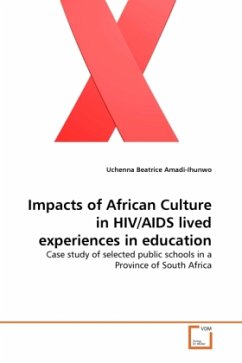
Early Language Experiences and School Success
A close look at the Kenyan multicultural environment
Versandkostenfrei!
Versandfertig in 6-10 Tagen
32,99 €
inkl. MwSt.

PAYBACK Punkte
16 °P sammeln!
Most Kenyan parents continue to place a high value oneducation for both boys and girls, believing thateducation will increase economic opportunities fortheir children as well as enable them to better serveand build their communities. But despite new opportunities created bythe changing political climate and subsequent changesin educational policies, many challenges still exist,particularly for families living in rural areas. Theachievement gap between urban and rural children isevident in the score reports from the primary schoolexit exam . Communities are largelyresponsible for providing faci...
Most Kenyan parents continue to place a high value on
education for both boys and girls, believing that
education will increase economic opportunities for
their children as well as enable them to better serve
and build their communities.
But despite new opportunities created by
the changing political climate and subsequent changes
in educational policies, many challenges still exist,
particularly for families living in rural areas. The
achievement gap between urban and rural children is
evident in the score reports from the primary school
exit exam . Communities are largely
responsible for providing facilities, operational
expenses, teaching equipment, teaching and learning
materials, and numerous indirect expenses such as
uniforms, transportation, and meals. Given the
poverty rates among rural Kenyan families, making the
most of the new educational opportunities has been
impeded by lack of economic opportunity, community
infrastructure, and human resources. Additional
obstacles are rooted in changes in family structure,
the impact of HIV/AIDS on the Kenyan population, and
the increasing number of parents working in urban
areas farther away from their children.
education for both boys and girls, believing that
education will increase economic opportunities for
their children as well as enable them to better serve
and build their communities.
But despite new opportunities created by
the changing political climate and subsequent changes
in educational policies, many challenges still exist,
particularly for families living in rural areas. The
achievement gap between urban and rural children is
evident in the score reports from the primary school
exit exam . Communities are largely
responsible for providing facilities, operational
expenses, teaching equipment, teaching and learning
materials, and numerous indirect expenses such as
uniforms, transportation, and meals. Given the
poverty rates among rural Kenyan families, making the
most of the new educational opportunities has been
impeded by lack of economic opportunity, community
infrastructure, and human resources. Additional
obstacles are rooted in changes in family structure,
the impact of HIV/AIDS on the Kenyan population, and
the increasing number of parents working in urban
areas farther away from their children.












